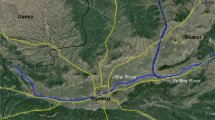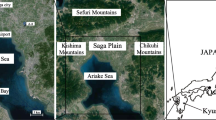Abstract
Large, deep-seated landslides are one of the most common geologic hazards in the Loess Plateau of northwestern China, especially in the Guanzhong area of Shaanxi Province. To understand why these landslides occur, we conducted a field investigation, remote sensing image interpretation, and physical and mechanical tests. Geologic surveys have shown that the landslide deposits are composed of thick loess, river terraces, and the Pliocene Sanmen Formation and that the rupture surface is located in the Sanmen Formation clay. Test results suggest that the Sanmen Formation material has a high clay content (particle diameters < 1.95 μm) and a substantial proportion of expansive clay minerals such as smectite or illite-smectite. In addition to high activity and high water content, the clay is also characteristically weak with poor cementation and high expandability. The peak and residual strength values exhibit large differences under natural and saturated states. It is inferred that the strength of the Sanmen Formation clay greatly decreases when infiltrated by underground water. The clay then becomes a weak layer which forms shear zones. These shear zones are what control the development and distribution of landslides along the edge of the Loess Plateau. This study is important for understanding the occurrence of large-scale loess landslides and assessing urban natural hazards in the western Guanzhong area of Shaanxi.












Similar content being viewed by others
References
Chen Y, Tong GB, Cao JD, Li ZH, Jia YK, Xu JM, Yang ZJ (1999) Tectonic climate response in the geomorphology of the Weihe River valley around Baoji, Shaanxi Province. J Geomech 5:49–56
Deng QD, Cheng SP, Min W, Yang GZ, Reng DW (1999) Discussion on Cenozoic tectonics and dynamics of Ordos block. J Geomech 5:13–20
Derbyshire E (2001) Geological hazards in loess terrain, with particular reference to the loess regions of China. Earth Sci Rev 54:231–260
Feng XJ, Tian QJ, Shen XH (2003) Analysis of activity difference of the west section of the Weihe fault. Geol Rev 49:233–238
Han HY, Mi FS, Liu HY (2001) Geomorphological structure in the Weihe Basin and neotectonic movement. J Seismol Res 24:251–257
He PY, Liu LS, Yu QH (1984) The age of the “Sanmen series” and the evolution of its depositional environment discussed in the light of the Dongpogou section in the Sanmen Gorge area. Geol Rev 30:161–169
Hu GT (1995) Landslide dynamics. Geological Publishing House, Beijing, pp 36–51
Hu HT, Xiang SJ, Wang ZF, Lin PQ, Chen X (1965) The characteristic constitution and structure of landslides in western Guanzhong region and analysis of their stability. Acta Geol Sin Eng 45:435–458
Li B, Wu SR, Shi JS (2012) Research and analysis on large-scale loess landslides in loess tableland area of Weibei. Res Soil Water Conserv 19(1):206–211
Liu DS, Zhu ZH (1959) Some opinions on Sanmen stratigraphic division. Sanmenxia Quaternary Geology Conference Proceedings, the Chinese Quaternary Research Committee. Science Press, Beijing, pp 63–68
Liu CZ, Zhang MX, Zou ZS, Li SS (1998) Research on the stability of Dijiapo slope in Baoji city. J Eng Geol 6:103–113
Meng XM, Dijkstra TA, Derbyshire E (2000) In: Derbyshire E, Meng XM, Dijkstra TA (eds) Loess slope instability. Landslides in the thick loess terrain of north-west China. Wiley, Chichester, pp 173–203
Pei WZ, Huang WB (1959) Some opinions on Sanmen series. Sanmenxia Quaternary Geology Conference Proceedings, the Chinese Quaternary Research Committee. Science Press, Beijing, pp 3–20
Sun J (1986) On yellow Sanmen and green Sanmen. J Xi’an Geol Coll 8:42–45
Tan CX, Sun WF, Zhang CS, Wu SR, Shi JS, Li B (2011) Engineering for typical geological loess section features from borehole cores in Baoji region of Loess Plateau. J Eng Geol 19(5):732–748
Wang YY (1982) Quaternary strata in the Wei river district of Shaanxi provice, Loess and quaternary geology, Xi’an: Shaanxi People’s Publishing House, 62–71
Wang YS, Hu HM, Li SL (1959) Some ideas on Sanmen stratigraphic age and causes. Acta Geol Sin Eng 39:167–187
Wang SB, Jiang FC, Wu XH, Wang SM, Tian GQ, Xue B, Zheng HB (1999) A study on the age of Sanmen group in Sanmenxia area. J Geomech 5:57–65
Wang SM, Wu XH, Zhang ZK, Jiang FC, Xue B, Tong GB, Tian GQ (2001) Environmental changes of Sanmen lacustrine deposits and the Yellow River flows eastwards. Sci China Ser D 31:760–768
Wang HB, Zhou B, Wu SR, Shi JS, Li B (2011) Characteristic analysis of large-scale loess landslides: a case study in Baoji City of Loess Plateau of Northwest China. Nat Hazards Earth Syst Sci 11:1829–1837
Williams AAB, Donaldson G (1980) Building on expansive soils in South Africa. Proc 4th Int Conf Expans Soils Denver. 834–838
Xue XX (1981) An early Pleistocene mammalian fauna and its stratigraphy of the River You, Weinan, Shensi. Vertebr Palasiat (Gujizhui Dongwu Xuebao) 19:35–44
Yue LP (1996) Depositional relation between the Loess, Red clay and sedimentation of the lake basin in the Loess Plateau. Acta Sedimentol Sin 14:148–153
Yue LP, Zhang YX, Wang JQ, Deng XQ, Zhang L (1999) Magnetostratigraphic sequence of continental deposits in Northern China since 5. 30 Ma. Geol Rev 45:444–448
Zhang YS, Qu YX (2000) Study on the engineering properties and engineering-environmental effects of neogene hardclays in south-west of Shandong Province. Chin J Geotech Eng 22:445–449
Zhang YS, Qu YX, Wu SR, Tan CX (2004) The discovery and preliminary research of Xianyousi clay (expansive clay) in the north edge of Qinling range. Geoscience 18:383–388
Acknowledgments
This work was conducted with financial support from the Ministry of Science and Technology of the People’s Republic of China (No. 2006BAC04B02) and the National Natural Science Foundation of China (No. 41102164). The authors would like to sincerely thank Prof. Yueping Yin, China Institute of Geo-Environment Monitoring, Prof. Shuren Wu, Chinese Academy of Geological Science, Dr. Jusong Song, Chinese Academy of Geological Science and Prof. Yongxin Qu, Institute of Geology and Geophysics, Chinese Academy of Sciences, for their support and help.
Author information
Authors and Affiliations
Corresponding author
Rights and permissions
About this article
Cite this article
Li, B., Feng, Z. & Wang, W.P. Characteristics of the Sanmen Formation clays and their relationship with loess landslides in the Guanzhong area, Shaanxi, China. Arab J Geosci 8, 7831–7843 (2015). https://doi.org/10.1007/s12517-015-1822-7
Received:
Accepted:
Published:
Issue Date:
DOI: https://doi.org/10.1007/s12517-015-1822-7




